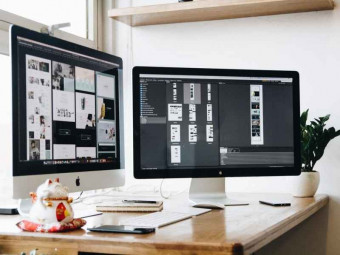Amazon Self Publishing
Avoid endless rejection letters from agents and publishers by self-publishing on the world's largest bookstore.
Last updated 2022-01-10 | 3.8
- Properly research your book ideas- to make sure they will be profitable before you start.
- Format your book as you write
- making publishing a breeze.
- Use the free promotion tools built into Amazon to kick start sales
- and then boost sales every so often.
What you'll learn
* Requirements
* You should be happy using a Word processor.* You should be planning to write a book
* or want to publish one you've already written.
Description
Have you ever wanted to publish a book on Amazon?
Even 10 years ago, seeing your books in print was a time-consuming, ego-sapping process that often involved untold rejection letters from publishers and agents. Even if you did strike it lucky and get a book deal, you shared most of the revenue with agents and other middle men.
Today, thanks largely to Amazon, self-publishing means anyone can write and publish a book. Within 48 hours of submitting your book, you can see it for sale on the largest online bookstore in the world. You can see your own book on your bookshelf, or on your Kindle device. How exciting is that?
Self-Publishing on Amazon Course
I have been successfully writing and publishing my own books on Amazon since 2012. It has been a great additional income stream for my business, and I want to teach you how you can do this too. This course will start at the very beginning and walk you through the entire process in a logical and steady manner. The course covers everything you need to know to start publishing your own books on Amazon in both Kindle format and as a paperback.
I'm not going to boast numbers like you see in many courses and books on this topic. My goal is not to impress you with numbers, but teach you how to self-publish.
In the introduction, I'll tell you a little bit more about my own background and why I am qualified to teach this course. You'll also see how some self-publishers hit it big when we look at the opportunities for self-publishers.
The course will teach you how to do your own market research into whether or not a book would be profitable. Once you decide on your topic, I'll take you through my process for brainstorming a book (possibly more useful for non-fiction writers), and creating a skeleton plan of the book from that brainstorming session.
I cannot teach you how to write well, but I will show you how to setup your Word processor to make the process of formatting your book easy. We'll cover some important issues like:
Self-publishing doesn't have to cost you anything, and the only exchange of money is when Amazon pays you. There is no money up-front for printing or stock charges, even if you use Createspace to publish your work as a paperback.
Why you cannot use any font you want, and how to find fonts you can use.
How to use headlines correctly, to help with the later creation of a table of contents.
What the pilcrow is, and how you can "turn these on" in Word, so as to avoid common "spacing" mistakes.
Proper use of page breaks to mark the start of new chapters.
How to add hyperlinks to a Kindle book, and how this differs from a hyperlink you want to include in a paperback.
How to manually insert bullet points if Kindle scrambles them during the conversion process.
What resolution images you should be using, and why you should resize images before inserting into your book. We'll look at an example of that.
Why screenshots represent a resolution problem, but why it's not as big a deal as you might think.
How to add page numbers to your document, and why you should do this even if you are only currently publishing on Amazon Kindle.
How to add a Table of contents, and make sure it is included in the Kindle App "goto" menu.
Whether you should hire an editor (I'll even give you the contact details for the one I use), and a budget-friendly way of doing it yourself with a free Word addon.
How to save your book in a format that can be uploaded to Kindle during the submission process.
Creating a simple book cover, and where you can get these done for you on the cheap.
A detailed list of the information you will need to include in the submission process, plus a worksheet with hints that you can use to collect all of the submission details in a single document.
How to use the worksheet from that last point to successfully submit your book to Amazon and sign up for KDP Select so you can take advantage of some great promotional tools only available to KDP Select authors.
How to setup an author profile on Amazon Central, and which countries you should create these profiles on.
How to use the Look Inside feature to pre-sell visitors on Amazon.
How to use other promotional tools offered by Amazon to KDP Select authors, like the free promo and kindle countdown.
How to check on book sales.
How to launch a book even if you don't have a list of subscribers.
Converting your book into a paperback, and submitting it to Amazon.
The course finishes with a bonus lecture that includes links to all of the resources listed in the course.
There is a famous quote that starts off "“Everybody has a book in them.."
If that is true, then ignore the second part of that quote which states "but in most cases that's where it should stay”, and get it published!
You have nothing to lose.
Can you imagine seeing your own book for sale on Amazon. Not just Amazon in your own country either. I'm talking about every Amazon store out there, in France, Germany, Italy, Japan, Australia, Mexico etc. etc.
This course can make your dream a reality.
You'll also be learning from someone that is still actively publishing books on Amazon, 5 years after his first book was published. Get started today and see your book on Amazon in as little as 48 hours!
Who this course is for:
- Anyone that wants to self-publish on Amazon.
- Budding authors that just want to publish their book, without endless rejection letters from publishers.
Course content
8 sections • 55 lectures
Introduction Preview 04:09
The introductory lecture will give you information on what to expect from this course, but just as importantly, your instructor. Find out why Andy Williams is qualified to teach you this course, and a little bit about his own self-publishing history.
Opportunities for Self-Publishers Preview 04:48
A few years ago, publishing a book was far from straightforward. You needed an agent and publisher to begin with, but even then it was an uphill struggle. Today, self-publishing allows anyone to produce and publish a book. What's more, it's easy to get that book into the largest online marketplace in the world - Amazon.
This lecture looks at a few successful people in the self-publishing space.
Pre-Course Question Preview 01:10
Before you start this course, I'd like to ask you a question.
Using Amazon for Market Research Preview 10:32
Amazon is a great place to do some market research, including checking out how many books are selling in your niche. This tutorial shows a couple of examples of how you can find out book sales volumes and other book details by visiting Amazon.com.
Planning Your Book Preview 06:39
It may depend on the type of book you are writing, but for non-fiction writers, it is worth planning out your book before you start to write it, I want to show you how I do it, with mind mapping.
Which Word Processor? Preview 03:55
You can use any Word Processor you like to write your books. I'll show you a few of the alternatives, and tell you which on I recommend and am using in this course.
Choose A Style Preview 02:41
To make the formatting of your book as simple as possible, you need to make correct and diligent use of Styles. This lecture looks at the styles in Word.
Fonts Preview 03:26
You cannot just use any fonts for your book. Fonts, like images, are owned by someone. You therefore have to be very careful about fonts used in your books and covers.
Headings Preview 06:23
The way you create your heading is important, as these are used to generate the table of contents. I'll show you how to correctly use headings, and also how you can quickly change the font, size or weight of the heading.
Paragraphs, Carriage Returns & Page Breaks Preview 06:23
When you are writing your book, it can be tempting to use the carriage return to space things out. Don't do it. It will mess up the formatting of the book in Kindle. Use Styles to control spacing, and page breaks to move chapter titles to new pages. This lecture shows you how.
Hyperlinks Preview 03:36
If you want to add links to webpages in your book, you can. E.G. If you are a fiction author, it makes sense to include a link back to your author site. If you write non-fiction, you might want to include URLs to important documents on the web.
The way you handle hyperlinks depends on whether you are creating Kindle only, or Kindle & Createspace paperbacks. This lecture explains how to insert hyperlinks into your books.
Bullets Preview 02:11
Bullet points can make non-fiction easier to read, but they can cause a headache with the final formatting. If you find your bullets don't render properly in your Kindle conversion, this lecture shows you how to insert them manually.
Write the Book Preview 03:09
I cannot help you write the book, but I can give you a few tips on how I go about it. This lecture looks briefly at creating a skeleton book, then just filling it in.
Images - Color or Black & White? Preview 06:05
Should you use colour or black and white photos in your books? And what resolution? This lecture explores these questions.
Images - Screenshots Preview 02:14
Screenshots are often found in non-fiction tutorial style books, but they do come with a few restrictions, namely resolution.
Page Numbers? Preview 04:59
Page Numbers are required for paperbacks, but not for Kindle. I recommend that if you are going to be publishing your book on Createspace too (paperbacks), that you insert page numbers when you start writing the book. During the process of saving for Kindle, these will be stripped out anyway.
Table of Contents Preview 04:37
All books, whether Kindle format or paperback, should have a table of contents (TOC). In this lecture, I'll show you how to add one, plus add a necessary bookmark to help Kindle find the TOC. Failure to do this last step could lead to your book being removed until you do.
Hire an Editor v DIY Preview 04:33
Bad grammar and spelling will lead to bad reviews. Bad reviews will kill the sales of your books.
Whether you hire an editor, or get a friend to proof-read your book, it does need to be done. You can also take the cheapest option and do it yourself.
Saving the Kindle Version, Ready for Upload Preview 08:36
Learn how to save your book in a format that can be imported directly into Amazon Kindle.
What About Paperbacks? Preview 00:15
A note about paperbacks.
Create an Account Preview 03:04
Before you can start publishing your book, you need to create an account on KDP. Actually, if you have an Amazon account, you can login with those details. If you don't have an Amazon account, you'll need to create one first and then login with the details.
Downloadable Worksheet Preview 03:08
A worksheet you can use as you go through the publishing process.
Kindle Book Covers Preview 07:29
Book Covers are really important, often providing a first impression to your potential customers. While I cannot help you design a cover, I can give you guidelines to follow and places to go if you want to hire someone to do this for you.
Language Preview 00:59
What language is your book? And is it supported by Amazon Kindle? This lecture shows you which languages are supported on Kindle.
TItle & SubTitle Preview 01:10
There are only a couple of guidelines for title, which are covered in this lecture.
A Series? Preview 01:22
Is your book part of a series? If it is, you can enter the series information, and this will help customers find other books in the same series.
Edition Number Preview 00:52
The edition of a book can tell customers whether the book is an original version, or a significantly updated later edition.
Contributors Preview 01:46
Who wrote the book? Did someone edit the book, or provide illustrations? Amazon gives you the opportunity to mention everyone that contributed.
Description Preview 02:24
The book description is your chance to pre-sell a potential customer. You have up to 4000 characters to do that. When someone finishes reading the description, you want them to be excited about reading your book.
Publishing Rights Preview 00:39
When you publish a book, you must specify whether you have the publishing rights of the book. This lecture looks at the options.
Keywords Preview 02:23
You need to choose 7 keywords that represent your book. These will help your book rank for your chosen phrases, so you need to choose words that are:
- Relevant
- Being searched for by Amazon visitors.
Categories Preview 06:12
You need to submit your book to two categories but it's not as easy as it sounds. This lecture mentions the BISAC system Amazon uses to categorise books, and how the actual categories you have to choose from are not the BISAC system.
Age & Grade Range Preview 01:01
Amazon will filter books according to age range and grade range. Therefore if you are writing books for a young market, these are worth filling in to make sure your book is shown to the appropriate audience.
Digital Rights Management Preview 00:54
DRM can help protect your book from unauthorized distribution.
Pricing & Commission Rates Preview 02:44
The final step in our preparations is to decide on a price for the book. The minimum price is 99 cents, but commission rates are linked to book price, so this lecture explains how this works.
Entering Book Details Preview 09:44
We've spent some time creating a checklist document that contains all of the information we need to publish our book on Amazon. In this lecture, we'll use that information and go through the publishing process.
Press Publish and What Happens Next Preview 00:47
So you've pressed the publish button. What happens next?
Look Inside Feature Preview 03:11
The look inside feature on Amazon gives customers a sneak peak at your book. You control that sneak peak, so make it count.
Author Central Preview 05:11
Author Central is your "profile" on Amazon. This lecture looks at how you can use Author Central to promote your books.
Free Promo Preview 05:55
If you are enrolled in KDP Select, Amazon allow you to give your book away for free. What's the point of that you ask? Watch the video to find out.
Kindle Countdown Preview 07:12
As part of the KDP program, you can create a Kindle Countdown promotion. This tutorial explains what they are.
Tracking Sales - Reports Preview 08:44
The KDP dashboard gives you all the tools you need to track sales.
A Book Release Strategy Preview 01:50
This is the release strategy I often follow, and recommend for new authors.
Important Preview 00:26
This lecture explains where to start when you come to publish your paperback.
Images in your Book Preview 02:50
This lecture looks at wrapping text around images for a cleaner layout, and the implications of doing so in terms of book length and printing costs.
Book Trim Size & Royalty Rate Preview 09:02
You need to decide on the size of your print book. The size you choose will have an impact on the royalty rate you receive per book sale. This lecture explains how it all works.
Checking Styles Preview 03:01
It's important to check the styles are correctly used in your document. This lecture shows you what to look for.
Check links Preview 01:49
Make sure all of the links in your document are correct and display in an easily typed format.
Overall Layout Checks Preview 07:01
It's important to go through your book, page by page, to check for any minor layout issues. I'll show you what to look out for in this video.
Page 1 Position Preview 02:45
The position of your first numbered page is important. Let's see how to make sure yours is correct.
Update the TOC Preview 02:37
The final check is to make sure the table of contents is correct, and updated. After updates, make sure your page numbers match the TOC.
Creating a Book Cover Preview 12:25
While I cannot teach you to use a graphics package in this course, I can show you the basics of creating your paperback cover.
Submit your Paperback Preview 09:44
The interior is done and checked, the cover complete. Now is the time to submit the book to Amazon KDP.
What now? Preview 00:40
This lecture finishes off the section on paperback publishing.
Bonus Lecture Preview 01:22
This bonus lecture includes all of the resources mentioned in this course.








 This course includes:
This course includes:
















